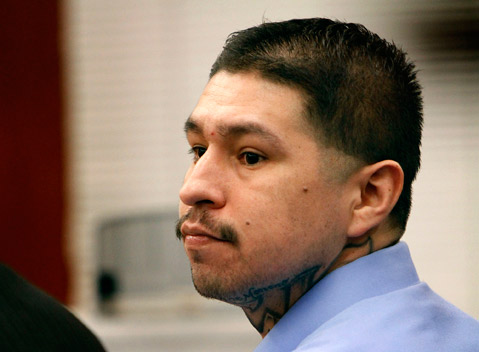Both Sides Score Points in Gang Injunction Trial
Closing Arguments Expected This Week

Over the past three weeks, attorneys on both sides of the proposed gang injunction have been landing solid points during the trial. Closing arguments are scheduled to take place in Judge Colleen Sterne’s courtroom later this week.
On Tuesday, Santa Barbara Police Detective Gary Siegel acknowledged that between November 2010 and August 2013, there was no evidence that Francisco Anaya had been involved in any criminal or gang-related activity. Anaya’s defense attorney William Makler noted that his client, an alleged Eastside gang member and one of the 11 defendants specifically named by City Hall in its injunction lawsuit, has been employed for the past seven years at Westmont College. He’s argued that his client is no longer active in the gang life and that he certainly doesn’t qualify as one of “the worst of the worst,” the phrase used by Police Chief Cam Sanchez to describe those named in the injunction when it was first proposed three-and-a-half years ago. During that time, Anaya, who still has gang tattoos, had only one minor citation when he refused a police order to stop while walking past a fight that occurred near his home. Anaya denied being involved in the fight, and the police have no evidence to contradict him.
When the injunction was first proposed, 30 individuals were named, but two weeks before the trial began, only 11 names remained. The missing 19 people are now either serving lengthy sentences in state or federal prisons or have dropped out of gang life. Makler expressed surprise that his client was not among those removed from the list and is hoping his client’s clean record will persuade the judge to do so.
Likewise, defense attorney Michael Hanley, with the Public Defender’s office, who represents Christian “Tweety” Botello, questioned the accuracy of police maps purporting to show the extent of gang activity within city limits between 2010 and 2013. While cross-examining Det. Siegel, the department’s foremost gang expert, Hanley established that the dramatic splatter of dots on a map denoting gang incidents failed to distinguish between gang-involved acts (those done specifically to further a street gang) and those that were committed by gang members but not necessarily part of gang activity. This would include, he argued, parole and curfew violations. By lumping such minor “gang involved” incidents with “gang related,” Hanley suggested, the Police Department created a gang-incident map that visually exaggerated the true extent of the gang problem. Defense attorneys readily concede that Santa Barbara criminal street gangs exist in Santa Barbara, but they contend the injunction is not necessary, because gang crime rates have been dropping. They believe this proves that traditional methods of law enforcement are handling the problem and that the gang injunction is an unnecessary and extraordinary method.
Combating this picture was prosecuting attorney Hilary Dozer, who emphasized the role played by the Mexican Mafia, a prison-based gang notorious for brutality and effectiveness within Santa Barbara gang circles. Under questioning from Dozer, Siegel outlined in some detail the transformation of Ray Macias in 1997 from a low-level street hoodlum with a weakness for heroin affiliated with the Eastside Krazies to the Mexican Mafia’s chief tax collector for all of Santa Barbara County. Macias is currently on trial in Santa Maria for torture and extortion involving a Lompoc drug dealer who failed to pay “taxes” to the Mexican Mafia. During a search of his home in connection with that arrest, Siegel said, police found Western Union receipts from Macias to Michael Moreno, a known Mexican Mafia leader now serving time in state prison. According to Siegel, Macias wired money into accounts controlled by Moreno. Macias has insisted that he did not direct or approve the torture that took place, that he was not present when it started, and that when he arrived, he ordered it stopped. His defense attorney noted that the witnesses against Macias have all received reduced sentences in exchange for their testimony.
In recent years, Macias also played a leadership role with the nonprofit Palabra, made up of former gang members who counseled active members against violent behavior. Law enforcement has expressed deep concern over the group because Palabra has expressly not urged individuals to renounce gangs, but instead to keep a lid on violent actions. As gang violence has declined in recent years, Palabra has taken partial credit, explaining that its members were showing up at hot spots and successfully putting out fires before they ignited.
Whatever the merits of this claim, it dovetails into the prosecution’s theory that gang violence has dropped throughout Santa Barbara because the Mexican Mafia ordered it. The most celebrated prosecution witness, Arthur Nevarez, whom the District Attorney’s office dramatically called Mister X, is a former Eastside leader looking at 87 years to life. He testified the Mexican Mafia ordered gang activity reduced pending resolution of the gang injunction trial. The Mexican Mafia, he testified, has recently “claimed” Santa Barbara, meaning drug dealers in gang territories have to pay taxes or risk violent retribution. In exchange for Nevarez’s testimony, charges of torture and extortion were dropped. If those dropped charges were still alleged in the trial, defense witnesses contend, Nevarez would have no hope of ever getting out of prison.
Before closing arguments, the defense put on seven witnesses who live in one of the two major gang “safety zones.” All testified that they do not live in fear of gang violence and that gangs do not constitute the “intolerable nuisance” that, by law, Judge Sterne must find in order to grant the injunction. Likewise, the defense presented a UCSB professor who testified that gang injunctions have only limited benefits for the affected communities and then only for short durations. According to scholarly peer-reviewed studies, gang injunctions have been linked with crime reductions of up to 11 percent in some communities, but according to the defense, those reductions do not last.



